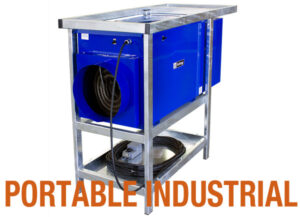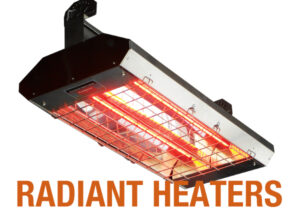Addressing Various Heating Demands of
Industrial Facilities With Electric Heat
Solutions For Every Application
Manufacturing/Industrial Plants usually consist of buildings and machinery, or more commonly a complex having several buildings, where workers manufacture goods or operate machines processing one product into another.
Whatever the combination, each area has specific heating requirements and there is an electric heating solution that is right for the job.
These buildings often present unique heating challenges that vary from room to room, requiring different heating solutions optimized for the specific application to ensure energy efficiency and maximum comfort.


WHY IT MATTERS?
The truth is that not every application in your building
has the same heating requirements but King has a solution for them all.
Now That’s Smart!
Always discuss with your HVAC specialist or installer to calculate a specific area’s heat loss requirements and to recommend the appropriate sized heater for your space.
Choosing The Right King Electric Heater For Various Areas In Manufacturing/Industrial Plants:
TEMPERING OUTDOOR AIR
Designed to “make up” the air in interior spaces that has been removed due to process exhaust fans. Pulls in fresh, tempered air from outside your building to replace existing air that cannot be recirculated.
VENTILATING SPACES
Use where environmental conditions warrant a greater need for ventilation not only to improve the quality of air within the building, but also protect the health of those inside.
LOADING DOCKS
Dock doors are constantly opening and closing and heat loss is unavoidable. Warm cargo and employees during active loading/unloading.
WAREHOUSES
Can be ducted to direct the heated air to required areas.
TEMPORARY EVENTS
Designed for use as primary or supplemental heat sources in large or exposed areas.
HAZARDOUS AREAS
Ideal for areas where a potential for explosion gases, vapors in the atmosphere. For indoor dry industrial applications, oil refineries, petrochemical plants, pulp and paper mills, grain elevators, hazardous waste storage facilities, wastewater treatment plants, etc
DRY OUT
Used for drying dampened or water damaged areas after water has seeped in.
CONSTRUCTION SITES
Perfect for temporary heating of spaces under construction.
LOADING DOCKS
Dock doors are constantly opening and closing and heat loss is unavoidable. Warm cargo and employees during active loading/unloading.
VENTILATION
Use where environmental conditions warrant a greater need for ventilation.
TEMPORARY EXHAUST
Can be used to temporarily exhaust contaminated, noxious or hot air away from workers and/or machinery.
DRY OUT
Used for drying dampened or water damaged areas after water has seeped in.
HIGH TRAFFIC AREAS
Large commercial wall heaters can create a pleasant transition between indoors and outdoors by providing heat inside vestibules and other entrances.
LARGE OPEN AREAS
Large lobbies and waiting rooms can be a challenge to keep warm.
STAIRWELLS
Stairwells are a prime target for supplemental heating in any multi-use space.
HIGH TRAFFIC AREAS
Large commercial wall heaters can create a pleasant transition between indoors and outdoors by providing heat inside vestibules and other entrances.
LARGE OPEN AREAS
Large lobbies and waiting rooms can be a challenge to keep warm.
STAIRWELLS
Stairwells are a prime target for supplemental heating in any multi-use space.
DRAFTY WINDOWS
Windows are a major source of heat loss and are prone to chilly drafts or condensation that obstructs views. Ideal for protection from cold air and condensation.
CONFERENCE ROOMS
Conference rooms and office spaces are susceptible to uncomfortable temperature changes and chilly drafts but require quiet heating solutions to avoid disruption.
OFFICES
Ideal for offices where comfort is required and noise is a major concern.
DRAFTY WINDOWS
Windows are a major source of heat loss and are prone to chilly drafts or condensation that obstructs views. Ideal for protection from cold air and condensation.
LARGE OPEN AREAS
Large lobbies and waiting rooms can be a challenge to keep warm.
LARGE OPEN AREAS
Large lobbies and waiting rooms can be a challenge to keep warm.
BREAK ROOMS
To help keep smaller kitchens comfortable, look for solutions that deliver maximum output in a compact frame.
BATHROOMS
Another room with a limited floor space, where wall and floor space are already utilized by plumbing and fixtures.
OFFICES
Ideal for offices where comfort is required and noise is a major concern.
ENTRYWAYS
Wall heaters can create a pleasant transition between indoors and outdoors by providing heat inside vestibules and other entrances.
BATHROOMS
Specifically designed to fit into bathroom cabinets, savings valuable floor and wall space.
BREAK ROOMS
To help keep smaller kitchens comfortable, look for solutions that deliver maximum output in a compact frame.
BATHROOMS
Another room with a limited floor space, where wall and floor space are already utilized by plumbing and fixtures.
BREAK ROOMS
To help keep smaller kitchens comfortable, look for solutions that deliver maximum output in a compact frame.
LOADING DOCKS
Dock doors are constantly opening and closing and heat loss is unavoidable. Warm cargo and employees during active loading/unloading.
STAIRWELLS
Stairwells are a prime target for supplemental heating in any multi-use space.
PARKING GARAGES
Designed for use as primary or supplemental heat sources in large or exposed areas.
LOADING DOCKS
Dock doors are constantly opening and closing and heat loss is unavoidable. Warm cargo and employees during active loading/unloading.
WAREHOUSE & SHIPPING
Spot heaters make cooler common areas more comfortable and keep employees productive.
BALCONY & PATIO
Tenants will appreciate the extended usefulness of balcony areas during the shoulder season.
MACHINE ROOMS
Elevator shafts, water lines, wiring, and other equipment are vulnerable to freezing when the temperature drops outside.
PLENUM SPACES
Ideal for concealed areas of buildings such as an area between a finished ceiling and drop ceiling, in an open plenum or in a ducted system.
MACHINE ROOMS
Elevator shafts, water lines, wiring, and other equipment are vulnerable to freezing when the temperature drops outside.
PUMP ROOMS
Designed to reduce moisture from mechanical equipment and keep pumps, valves, and farm machinery from freezing.
ROOF SNOW MELT
Self-Regulating Heating Cable prevents Ice Damns from forming on roofs & in gutters.
GUTTER DE-ICING
Automatically adjusts heat output based on surface temperature and suitable for metallic and non-Metallic Gutters & Downspouts
ROOF DRAINS
For use with SR Self-Regulating De-Icing Roof & Gutter Heating Cable to keep drains clear all winter long. Easy install without anchoring through the roof membrane.
AC DRAINS
Condensate drain line are exposed to freezing temperatures and winter weather, which could cause the line to freeze up and become blocked.


















